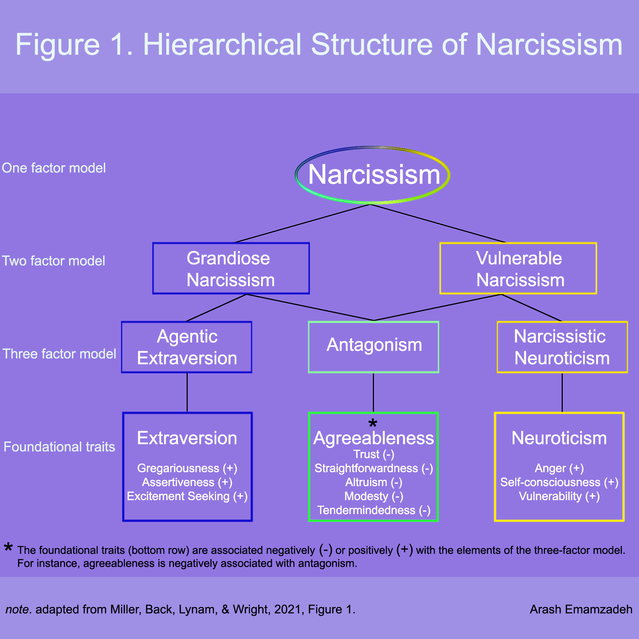Narcissism
What New Research Is Telling Us About Narcissism
... and what we still don't know.
Posted February 28, 2022 Reviewed by Ekua Hagan
Key points
- Narcissism consists of grandiose and vulnerable forms and a mix of antagonism, extraversion, and neuroticism.
- Some narcissists (i.e., grandiose narcissists) are more likely to have high self-esteem.
- However, narcissism is not the same as self-esteem.
- Narcissists show keen attention to cues related to status, constantly seeking ways to improve theirs.
Published in the December issue of Current Directions in Psychological Science, a paper by Miller et al. discusses the latest research on narcissism, such as factors that motivate narcissistic behavior and the relationship between narcissism and self-esteem. This post is a selective summary of this paper.
First, what do we mean by narcissism?
Narcissistic individuals are perhaps best described as grandiose. They are excessively proud, entitled, exploitative, envious, and jealous. Narcissists commonly behave in self-enhancing and self-promotional ways (e.g., displaying their wealth or achievements) but also aggressively toward rivals.
Many narcissists have an accurate understanding of how they are negatively viewed but either do not care or think these views are wrong.
The Structure of Narcissism
One line of research suggests narcissism consists of two dimensions.
- Grandiose narcissism: Linked with “arrogance, entitlement, higher self-esteem, gregariousness, aggression, perceived likability, risk-taking, and a zero-sum interpersonal approach.”
- Vulnerable narcissism: Linked with “egocentrism, low and variable/contingent self-esteem, distrust of others, broad and enduring negative affectivity, and social isolation.”
The second line of research supports a three-factor model of narcissism.
- Antagonism (a.k.a. entitlement or rivalry): High antagonism is associated with characteristics such as a sense of entitlement, deceitfulness, arrogance, callousness, being distrustful (e.g., seeing people as evil), and taking advantage of others. Antagonism is a component of both vulnerable narcissism and grandiose narcissism.
- Agentic extraversion (a.k.a. grandiosity or admiration): Narcissists with higher agentic extraversion are assertive, proactive (not reactive), reward-seeking (than punishment-avoidant), and tend to have higher self-esteem. Agentic extraversion is linked more strongly with grandiose narcissism than with vulnerable narcissism.
- Neuroticism (a.k.a. vulnerability): Higher levels of neuroticism correlate with unstable or low self-esteem, self-conscious emotions (e.g., shame), difficulties regulating one’s emotions, and relationship problems. Neuroticism is linked more closely with vulnerable narcissism than with grandiose narcissism.
See Figure 1.

Various characteristics associated with the three factors above (plus vulnerable narcissism and grandiose narcissism) are found in the criteria for narcissistic personality disorder (NPD), as described in the Diagnostic and Statistical Manual of Mental Disorders (DSM-5).
Narcissism and Self-Esteem
While some components of narcissism, like agentic extraversion, correlate with high self-esteem, other components (antagonism and particularly neuroticism) are associated with low self-esteem.
In the two-factor model of narcissism, grandiose narcissism, not vulnerable narcissism, tends to correlate with high self-esteem. This is not surprising, since grandiose narcissism is associated with extroversion, assertiveness, and approach orientation.
However, even the relationship between grandiose narcissism and high self-esteem is complex. For instance, self-esteem is unrelated or even negatively related to certain aspects of grandiose narcissism, like coldness, manipulativeness, or aggressive or attention-seeking tendencies. Indeed, at higher levels, grandiose narcissism is less strongly related to self-esteem.
In summary, narcissism and self-esteem differ in significant ways.
What Motivates or Causes Narcissistic Behavior?
Narcissists often behave in disagreeable ways. For example, they play games, lie, pick fights, disrespect or violate personal boundaries, and create chaos.
Narcissists also behave in perplexing or contradictory ways. For example, on the one hand, a narcissist may project a sense of superiority and self-sufficiency, and repeatedly look down on and ignore, reject, or psychologically abuse others (even friends and family). On the other hand, the narcissist may behave in ways that indicate a strong need for attention and regard from those same mistreated individuals.
So, how do we explain narcissistic behavior?
Some clinical theories (e.g., the psychodynamic mask models of narcissism) suggest narcissists’ external grandiosity and superiority mask an inner sense of fragility, insecurity, and self-doubt.
Research support for the mask model, however, is limited. For example, although neurotic and antagonistic components of narcissism are associated with lower self-esteem, this is not so for the agentic components of narcissism. Nor does research support the view that higher explicit self-esteem coexists with lower unconscious or implicit self-esteem.
More recent theories of narcissism (e.g., the status pursuit models of narcissism) suggest the desire for social status motivates narcissistic behavior, particularly in grandiose narcissism.
Indeed, narcissists show keen attention to cues related to status and position, constantly seeking situations that could afford them a higher status. In such situations, narcissists skillfully engage in self-promotion and self-enhancement. But if these behaviors are unsuccessful (or likely to be unsuccessful) they engage in derogating and devaluing the competition. In short, narcissists use different techniques to increase their own status and/or decrease others’ status.
The Social Dynamics of Narcissism
Whether narcissists get under people’s skin depends partly on the social context. Social context could encourage the expression and acceptability of certain narcissistic behaviors. To illustrate, a narcissist giving a speech at a rally or a business meeting can say grandiose things that would not be acceptable if she were talking to people at a party.
In general, when we meet narcissists for the first time, we are more aware of the agentic aspects of narcissism (e.g., the narcissist coming across as self-assured and assertive). Only in the more intimate interactions (friendships, romantic relationships) do narcissists’ antagonistic tendencies (e.g., fighting, bullying, abusive behavior) become pronounced.
Unanswered Questions About Narcissism
More research is needed to better understand the biological causes of narcissism (e.g., genetics), the development of narcissism (e.g., parental overvaluation vs. neglect), the core of narcissism (e.g., antagonism vs. agentic extraversion vs. shame), the relationship between communal narcissism and agentic narcissism, and whether narcissists can change (either due to personal experiences or during therapy).
To learn more, see my Q&A with the first author, Josh Miller, here and here.
Facebook/LinkedIn image: fizkes/Shutterstock




